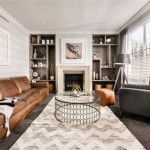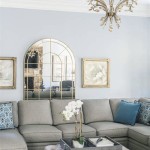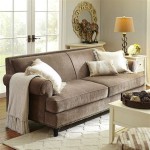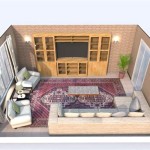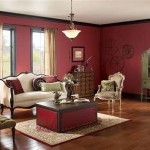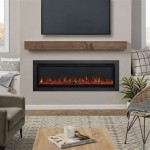Living Room Light Gray Walls: A Comprehensive Guide to Style and Application
Light gray, a versatile and increasingly popular neutral, has become a staple in interior design, particularly for living room walls. Its adaptability and capacity to complement a wide range of furniture styles and color palettes make it a favored choice among homeowners and designers alike. The implementation of light gray in a living room setting can create a soothing, sophisticated, and inviting ambiance.
This article will explore the numerous advantages of using light gray for living room walls, delve into the factors influencing the selection of the perfect light gray shade, and offer practical advice on coordinating light gray walls with furniture, accessories, and lighting to achieve a cohesive and aesthetically pleasing living space.
The Advantages of Light Gray Walls in a Living Room
Light gray provides numerous advantages compared to other wall color options. Its inherent neutrality acts as a blank canvas, allowing for greater flexibility in decorating and redecorating over time. Unlike bolder, more saturated colors, light gray does not dictate a specific style or limit future design choices. This adaptability is particularly beneficial for individuals who enjoy frequently updating their living room's aesthetic.
Furthermore, light gray possesses the unique ability to enhance natural light within a room. It reflects light effectively, creating a brighter and more spacious feel. This characteristic is especially valuable in smaller living rooms or spaces with limited natural light sources. A light gray wall can significantly improve the overall brightness and airiness of a room, contributing to a more positive and welcoming environment.
Beyond its functional advantages, light gray also contributes to a sense of tranquility and sophistication. Its subtle and understated nature promotes a calming atmosphere, making it an ideal choice for a living room, which is often a space intended for relaxation and socializing. The color's association with modernity and elegance further enhances its appeal, allowing it to seamlessly integrate into a variety of design styles, from minimalist to traditional.
Selecting the Right Shade of Light Gray
Choosing the appropriate shade of light gray is crucial to achieving the desired aesthetic effect. The undertones present in a particular gray paint can significantly influence the overall feeling of the room. Light grays can possess warm undertones, such as yellow or beige, or cool undertones, such as blue or green. Understanding these undertones is essential for selecting a shade that complements the existing furniture and architectural elements of the living room.
For instance, a light gray with warm undertones will pair well with natural wood furniture and earthy color palettes, creating a cozy and inviting atmosphere. Conversely, a light gray with cool undertones will complement cooler color schemes, such as blues, greens, and purples, and create a more modern and sophisticated look. The existing lighting within the room also plays a critical role in how the gray paint will appear. Natural light tends to enhance cool undertones, while artificial light, particularly incandescent lighting, can bring out warmer undertones.
Sampling different shades of light gray paint is highly recommended before committing to a final decision. Paint samples should be applied to various areas of the wall and observed at different times of day to assess how the color changes under varying lighting conditions. Considering the existing furniture and decor when testing the samples will also provide a more accurate representation of the final result.
Another factor to consider is the level of sheen. Different paint sheens reflect light differently, impacting the perceived color and texture of the wall. Matte finishes tend to absorb light, creating a softer and more muted look, while glossier finishes reflect light, making the color appear brighter and more vibrant. The choice of sheen should be based on the desired aesthetic and the practical needs of the space. For example, higher sheen paints are typically more durable and easier to clean, making them suitable for high-traffic areas or households with children or pets.
Coordinating Light Gray Walls with Furniture and Accessories
The versatility of light gray walls allows for a wide range of furniture and accessory choices. However, careful consideration should be given to the color palette, textures, and overall style to achieve a cohesive and harmonious living room design. Contrasting colors can create visual interest and prevent the space from feeling monotonous.
For example, incorporating furniture in saturated colors such as navy blue, emerald green, or mustard yellow can create a striking contrast against light gray walls. These bolder colors can be introduced through sofas, armchairs, or accent pieces. Conversely, a monochromatic color scheme can be achieved by pairing light gray walls with furniture in varying shades of gray, white, and black. This approach creates a sophisticated and minimalist aesthetic.
Texture plays a crucial role in adding depth and dimension to a living room with light gray walls. Incorporating a variety of textures through rugs, pillows, throws, and artwork can prevent the space from feeling flat or uninviting. Natural materials such as wood, linen, and wool can add warmth and tactility, while metallic accents can introduce a touch of glamour and sophistication.
Lighting is another essential element to consider when coordinating with light gray walls. The type and placement of lighting fixtures can significantly impact the overall mood and ambiance of the room. Warm lighting, such as incandescent or LED bulbs with a warm color temperature, can create a cozy and inviting atmosphere, while cool lighting, such as fluorescent or LED bulbs with a cool color temperature, can create a more modern and energizing feel. Layering different types of lighting, such as ambient lighting, task lighting, and accent lighting, can enhance the functionality and visual appeal of the living room.
Artwork and accessories should be carefully selected to complement the light gray walls and the overall style of the living room. Large-scale artwork can serve as a focal point, while smaller accessories, such as vases, candles, and decorative objects, can add personality and character. The color and style of the artwork and accessories should be consistent with the overall color palette and design aesthetic of the space.
Plants can also significantly enhance a living room with light gray walls. Greenery adds a touch of freshness and vitality, creating a more inviting and relaxing atmosphere. Plants also help to purify the air and improve the overall indoor environment. Choosing plants with varying sizes, shapes, and textures can add visual interest and create a more dynamic and layered look.
Curtains and window treatments are essential in controlling natural light and adding privacy to a living room. The color and style of the curtains should complement the light gray walls and the overall design aesthetic of the space. Sheer curtains can allow natural light to filter through, creating a soft and airy feel, while blackout curtains can provide privacy and block out unwanted light. The length of the curtains should also be considered; longer curtains can create a more dramatic and elegant look, while shorter curtains can create a more casual and relaxed feel.
The type of flooring in the living room also influences the overall look and feel. Light-colored flooring, such as light wood or light-colored carpet, can create a bright and spacious feel, while dark-colored flooring, such as dark wood or dark-colored carpet, can create a more dramatic and sophisticated look. The choice of flooring should be based on the desired aesthetic and the practical needs of the space. For example, hardwood flooring is durable and easy to clean, while carpet is more comfortable and provides better sound insulation.
In conclusion, light gray walls offer a versatile and sophisticated backdrop for creating a stylish and inviting living room. By carefully considering the undertones of the gray paint, coordinating with furniture and accessories, and incorporating appropriate lighting, it is possible to transform a living room into a comfortable and aesthetically pleasing space.

45 Living Room With Gray Wall Color Design Ideas Matchness Com

Light Gray Walls And A Kitchen In Bright Historic Apartment Coco Lapine Designcoco Design

Color Guide How To Work With Light Gray

Cool Grey Walls Many Art Pieces And Muted Pink In The Kitchen Coco Lapine Designcoco Design

Dark Accent Wall Light Gray Walls Thrifty Decor Chick Diy And Organizing

Grey Living Room Ideas 44 Ways To Make This Timeless Neutral Colour Work For Your Lounge In 2025

Grey Accent Wall Ideas For Your Living Room And Bedroom

Light Grey Living Room Walls And An Olive Green Bedroom Coco Lapine Designcoco Design

Grey Carpets Top 7 For Your Bedroom Living Room More Architecture Design

White Room With Light Gray Ceiling Design Ideas

